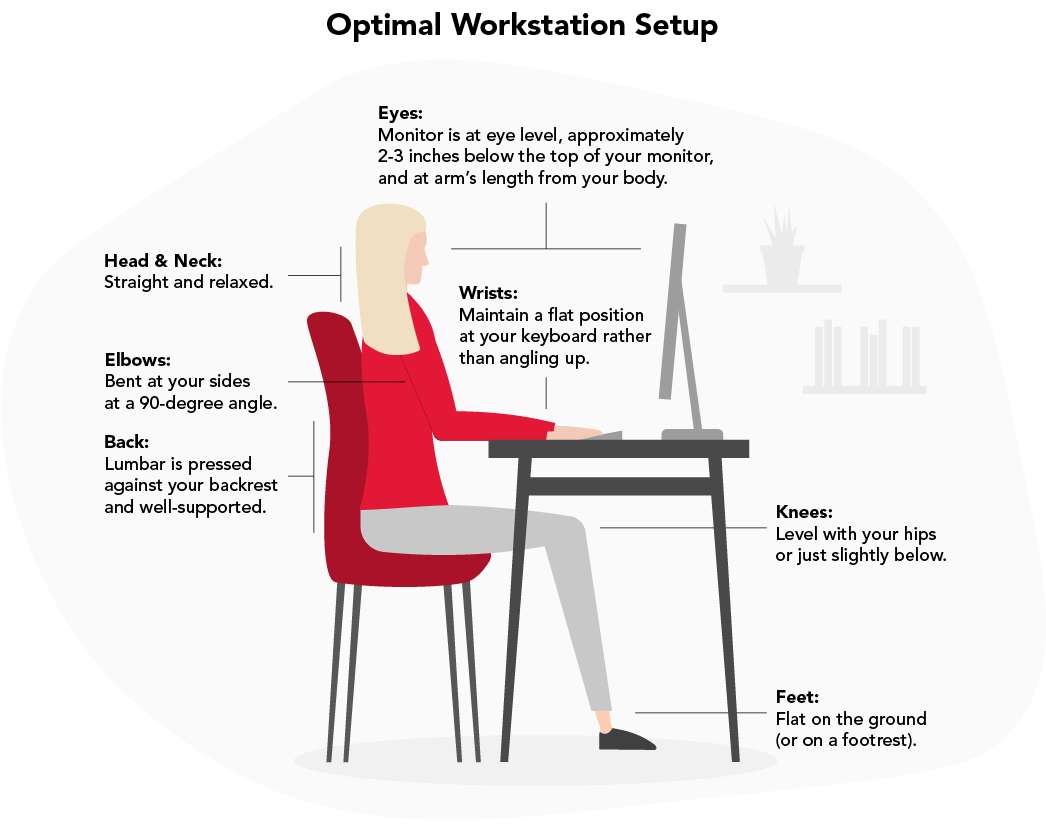Processing Your Payment
Please do not leave this page until complete. This can take a few moments.
- News
-
Editions
View Digital Editions
Bi-Weekly Issues
- April 29, 2024 - Power 100
- April 15, 2024
- April 1, 2024
- March 18, 2024
- March 4, 2024
- Feb. 19, 2024
- + More
Special Editions
- Lists
- Viewpoints
- WBJ Events
- Business Calendar
- Biz Marketplace
5 Tips for Alleviating Neck and Back Pain While Working from Home

Before the pandemic, we were all a little more mobile. Commuting to and from work, walking from desks to meetings or even just getting up to chat with a coworker, leisurely movement was more naturally incorporated into the workday. Now, with many Americans still working remotely or on a hybrid schedule, and with desks down the hall from bedrooms, that much-needed mobility is more difficult to come by.
Decreased movement and increased sitting time, compounded by the stress that often comes with a workday, can take a toll on our bodies. Specifically, prolonged sitting can be the culprit behind neck and back pain, which four out of five Americans had already reported experiencing pre-pandemic. While the discomfort might not seem like a major red flag, over time it can damage our spinal structures and contribute to prolonged and even permanent pain in our necks, shoulders and backs.
Here are some tips and tools you can implement to stay comfortable during your workday and combat neck and back pain and associated long-term damage:
1) Check your workstation ergonomics.
If you’re currently working from the couch or dining room table of your home, you’re probably not getting the appropriate support for a good postural position. And if you do have a dedicated setup, you could still be putting pressure on your back and neck with a structure that isn’t suited to your body. To relieve strain and prevent injury, use this head-to-toe reference when considering your body placement at your desk area and overall workstation setup:

2) Remember to move.
Sitting for long periods of time can lead to muscle and joint stiffness in your neck and back causing you to develop pain and discomfort. Research shows that frequent stretching not only prevents discomfort, it can also improve range of motion and posture, as well as provide stress relief. To promote healthy circulation throughout your workday and keep your body moving, try implementing these three tips:
- Move every 30. Break up sitting time by getting up and moving for one to five minutes every half hour and periodically working from a standing position using a standing desk or high counter.
- Stretch it out. During these quick breaks, try a variety of stretches that target your neck, back, shoulders, legs and knees. You can even do these stretches right at your desk.
- Use digital tools. StretchMinder for iPhone users, Stretching & Eye Exercises for Android users and the Stretch Reminder Google Chrome extension for Chrome users not only remind you to get up, they also share exercises and activity suggestions for healthy movement.
3) Commit to regular exercise.
Research from The Office of Disease Prevention and Health Promotion shows that 80% of adults are not meeting the recommended guidelines for aerobic and muscle-strengthening activities. For healthy adults, this includes at least 150-300 minutes (5 hours) a week of moderate-intensity, or 75-150 minutes (2 hours and 30 minutes) a week of vigorous-intensity aerobic physical activity, or an equivalent combination of the two. Regular exercise, especially the kind that involves strengthening the muscles in your neck, shoulders and back, is critical for reducing and preventing neck and back pain. Incorporate a combination of these workouts into your routine using dumbbells, resistance bands and body weight. Additionally, through Harvard Pilgrim’s Living Well at Home program, anyone can jump into a 30-minute strength class between meetings or a one-hour Zumba class after hours.
4) Explore treatment options.
Prior to the pandemic, about 22 million Americans visited chiropractors annually with 35% seeking relief from back pain. While you should always connect with your primary care physician first on what’s right for you, healthcare options like chiropractic and acupuncture sessions can be an efficient way to alleviate and manage back and neck pain caused by sedentary work. If you’re a Harvard Pilgrim Health Care member, your plan might also include coverage for chiropractic and acupuncture visits. For Massachusetts employers with 51+ employees who are interested in providing their employees access to these benefits, Harvard Pilgrim’s new offering, Health Forward, includes unlimited chiropractic and acupuncture visits.
For more general information, you can also learn more about how chiropractic and acupuncture treatments work to relieve pain and restore mobility.
5) Take care of your mental health.
Outside of physical causes, neck and back pain can also be the result of psychological stress. In a report released October of 2020, eight in ten adults reported feeling significantly stressed due to the pandemic. While exercise can be a powerful stress reliever, making time for activities that bring you joy (this even includes laughing) can help reduce stress. Activities like yoga, mindfulness and meditation in particular are also beneficial. Join a free mindfulness session up to twice per week through Harvard Pilgrim’s Living Well at Home Program. Also, members have access to accredited mental health professionals, including through online therapy and text-based counseling tools like Talkspace or Sanvello. And, with Health Forward from Harvard Pilgrim, the first two behavioral health office visits, as well as all virtual behavioral health visits, carry a $0 copay, Contact your health insurance broker for more information on this new offering.
A sedentary, work from home job doesn’t have to be a pain in the neck. By implementing these tips and strategies long-term, you can help your body stay mobile, flexible and stress-free as you continue to work from home or head back to the office.

Get the Daily Report
Stay connected! Every business day, WBJ Daily Report will be delivered to your inbox by noon. It provides a daily update of the area’s most important business news.
Sign up
Subscribe
Worcester Business Journal provides the top coverage of news, trends, data, politics and personalities of the Central Mass business community. Get the news and information you need from the award-winning writers at WBJ. Don’t miss out - subscribe today.
Subscribe
Worcester 300, City of Innovators
Worcester Business Journal presents a special commemorative edition celebrating the 300th anniversary of the city of Worcester. This landmark publication covers the city and region’s rich history of growth and innovation.
See Digital Edition-
Get the Daily Report
Stay connected! Every business day, WBJ Daily Report will be delivered to your inbox by noon. It provides a daily update of the area’s most important business news.
-
Subscribe
Worcester Business Journal provides the top coverage of news, trends, data, politics and personalities of the Central Mass business community. Get the news and information you need from the award-winning writers at WBJ. Don’t miss out - subscribe today.
-
Worcester 300, City of Innovators
Worcester Business Journal presents a special commemorative edition celebrating the 300th anniversary of the city of Worcester. This landmark publication covers the city and region’s rich history of growth and innovation.
ABOUT
NEW ENGLAND BUSINESS MEDIA SITES
No articles left
Get access now
In order to use this feature, we need some information from you. You can also login or register for a free account.
By clicking submit you are agreeing to our cookie usage and Privacy Policy
Already have an account? Login
Already have an account? Login
Want to create an account? Register
Get access now
In order to use this feature, we need some information from you. You can also login or register for a free account.
By clicking submit you are agreeing to our cookie usage and Privacy Policy
Already have an account? Login
Already have an account? Login
Want to create an account? Register